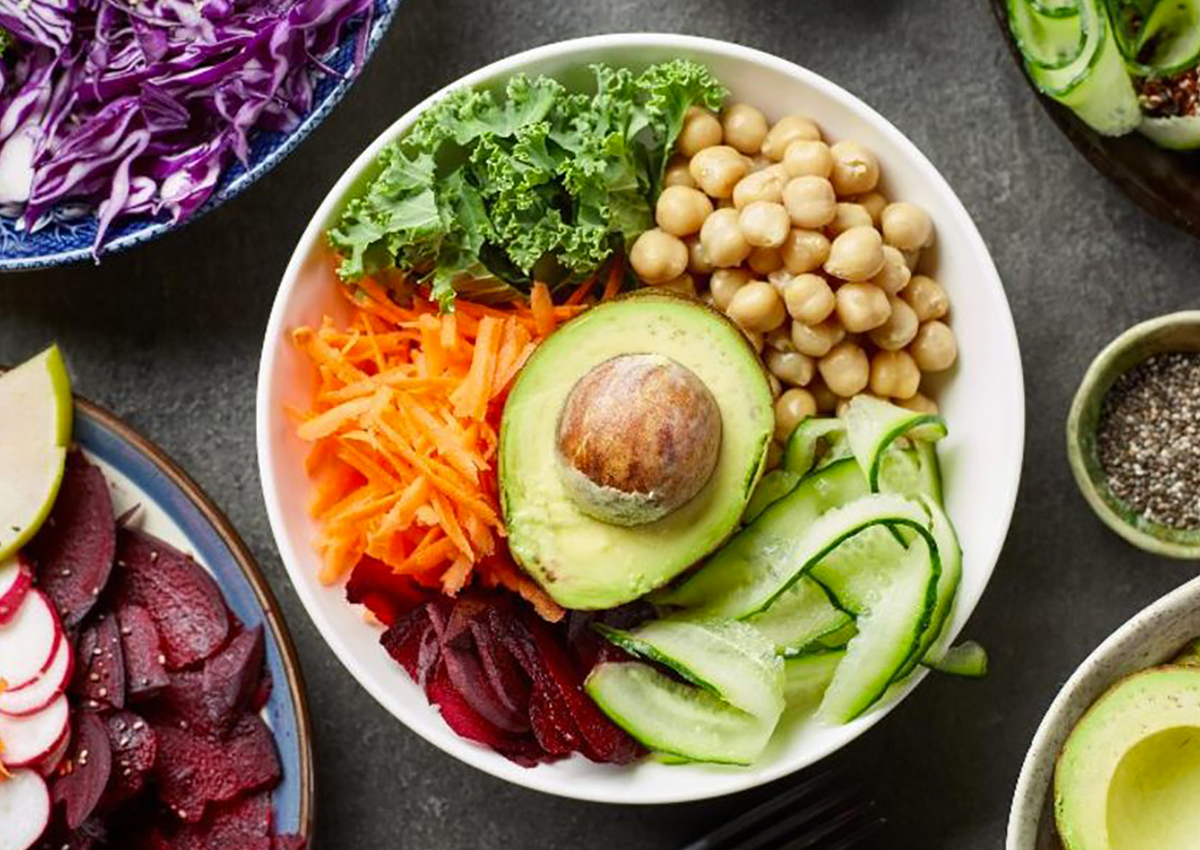
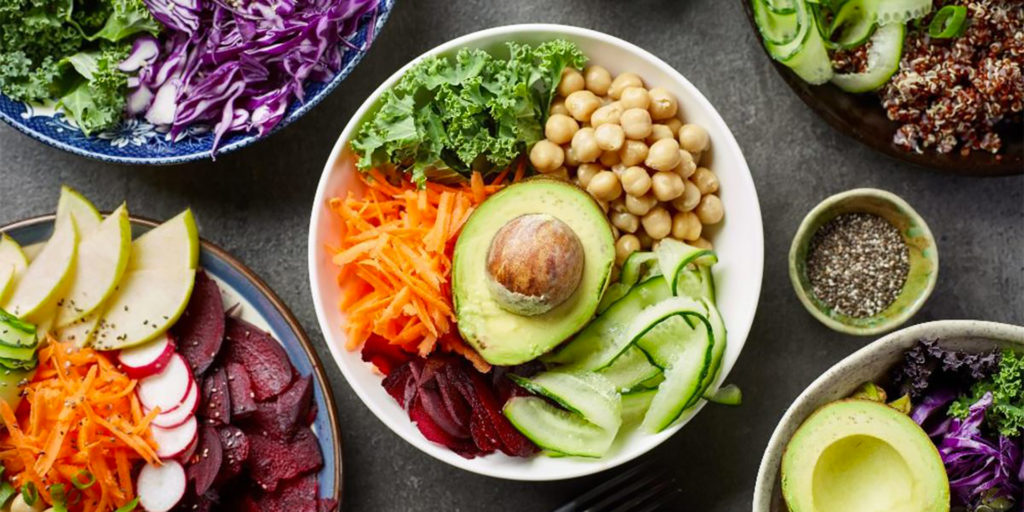
Talking about yogic nutrition means above all referring to foods that not only bring energy and lightness but also peace, harmony and joy. Healthy eating is the basis of health and well-being.
Yogic nutrition according to the gunas
The choice of food according to the science of yoga is made on the basis of some factors.
The first factor is related to the “vibrational” quality of food, in other words, when we eat we acquire the energy vibrations prevailing on our plate, therefore we must pay attention. The vital energy, in its continuous flow through the animated things of this universe, is expressed according to three factors (gunas) that the ancient yogis classified in this way:
Sattva: harmonious and regular flow of energy
Rajas: agitated and disordered flow of energy
Tamas: static phase of energy, inertia
Each food, like everything in this universe, is characterized by a different proportion of these three factors: certain foods have a strong “rajasic” characteristic that makes them exciting, other foods having a strong “tamasic” component make the mind dark and very rough body.
The right food for the yogi is therefore “sattvic“, which provides the body and mind with good quality energy and with harmonic vibration, a food that favors the practice of meditation and yoga.
Let’s see how the various foods are divided according to this system.
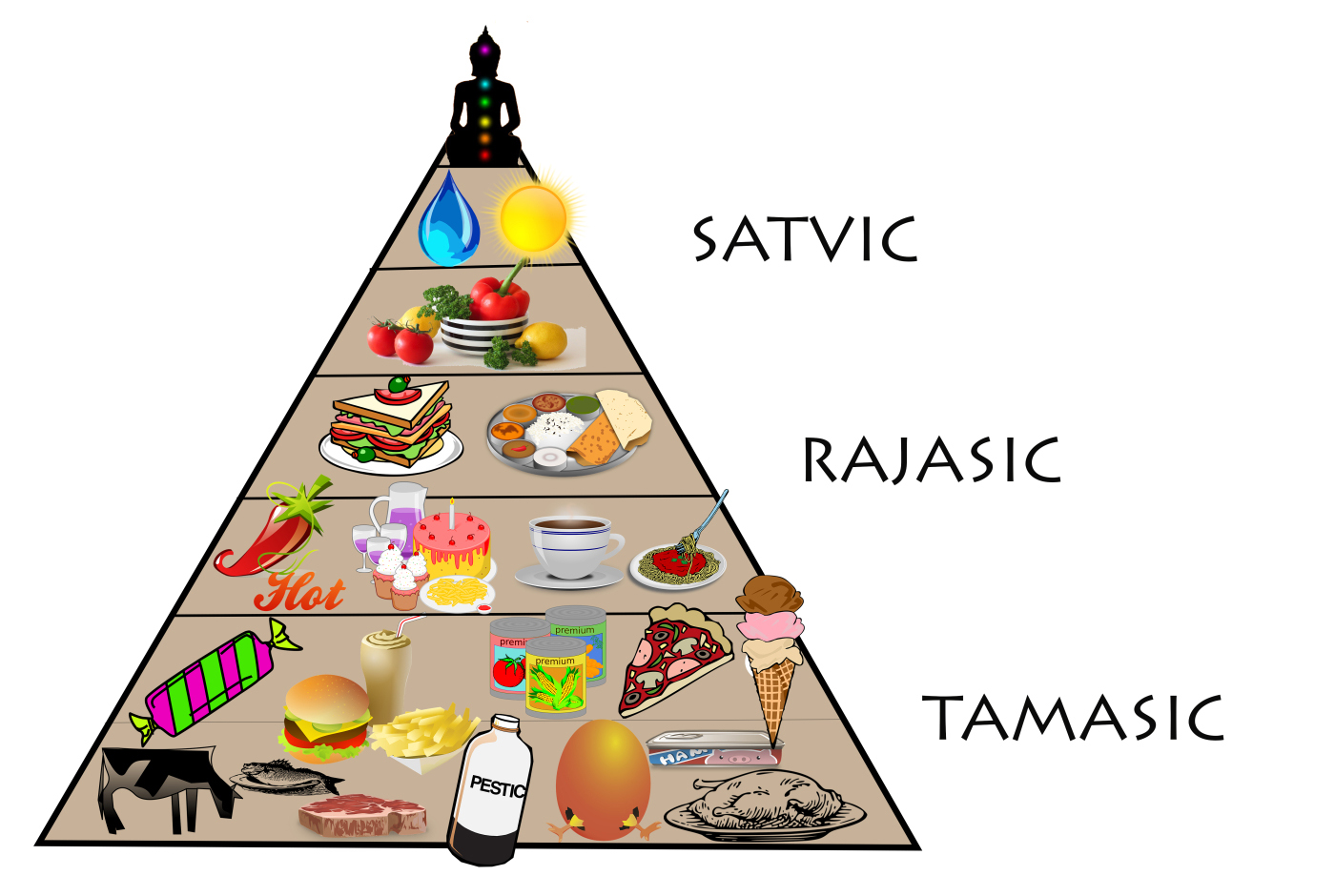
Sattvic foods are those that possess the highest and highest qualities. They help keep the body healthy, increase its strength and vitality, maintaining the correct acid/alkaline balance and improving mental functions and spirituality. They bring joy, peace, harmony, lightness, clarity of mind, wisdom, light, purity.
They are foods of mainly vegetable origin.
Sattvic foods are: whole grains (especially rice), legumes, oil seeds, non-spicy spices, honey, walnuts, hazelnuts, cashews, ghee, quality oils (extra virgin olive oil, sesame oil), fruit and vegetables (apart from some that are rajasic), herbal teas, homeopathic and naturopathic medicines.
Rajasic foods nourish the body but promote activity, action, excitement and therefore disturb the mind creating restlessness. People who are very active physically and mentally benefit from it, but they should be avoided by those who want to keep a calm mind and believe in a path of spiritual growth. These foods stimulate passion, excitement, action. They should not be avoided but consumed moderately, never before or after yoga.
Rajasic foods are: chilli, pepper and other spicy spices, solanaceae, coffee, black tea, chocolate, refined, frozen and canned foods, brown sugar.
Tamasic foods are foods without vitality, they weaken the body and darken the mind. They take away energy and provoke inertia, closure, anger, confusion on a mental and emotional level. They are foods that are difficult to digest and unfortunately nowadays they represent a large amount of the food that is normally consumed. These foods should be avoided.
Tamasic foods are: meat and derivatives, fish and seafood, eggs, garlic, onions, leeks, mushrooms, heated foods, pre-cooked foods, alcohol, aged cheese, white sugar, carbonated drinks, freeze-dried foods, all junk food in genus, not fresh or rotting food. Eating too much also turns food into Tamasic.
Rajasic food can become sattvic in those places where the temperature drops below zero, while sattvic food becomes tamasic if ingested in excessive quantities.
We therefore see that the yogi’s diet is a vegetarian diet. This is not only determined by the choice of foods according to the gunas, but in this article I will also explain other reasons that determine this choice.
The vital energy of food
The second factor is related to the concept of life: life comes from life. A healthy food must therefore bring with it vital energy, for this reason a yogi does not eat “dead” foods. Meat with all its derivatives, fish and all “seafood” are foods that arrive dead on our plate. Our body will be able to take some nutrients from these foods but it will certainly not take a good dose of vital energy, as this has already abandoned the material, physical part of the food for some time.
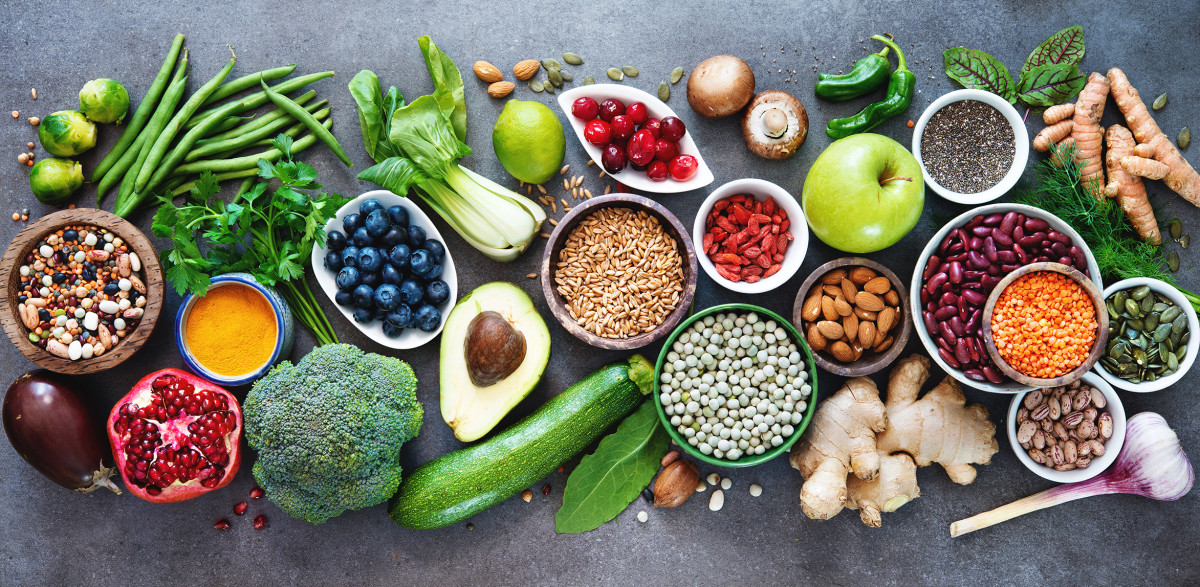
Respect for life and the principle of non-violence
The third factor is linked to the ethical principles of yoga: respect for life is the basis of this choice. A yogi, striving to achieve peace, follows the path of “non-violence” (Ahimsa).
According to Tantra, plants and animals also have a conscience and, having the possibility to choose, it would be necessary to sacrifice the less developed form of consciousness. So before slaughtering an animal one should always think about whether it is actually essential to seize that life. Eating fruit or vegetables, for example, does not involve “killing” the plant, and even if in other cases a plant is sacrificed for our diet, the impact on the surrounding nature is certainly less than that caused by the killing of an animal.
The nature of the human being
The fourth factor is related to the nature of man’s digestive system: if we compare the physical and physiological characteristics of man with those of carnivorous and herbivorous mammals, we will conclude that man is not a carnivore!
The intestines of carnivorous animals, for example, are very short while the stomach of these animals is very large; in fact, the meat enters a state of putrefaction very quickly and for this reason it must be digested well (large stomach) and expelled quickly from the body (short intestine). Man has a much smaller stomach than that of carnivorous animals, and also has a very long intestine just like herbivorous animals, so the meat in our body does not have enough time to be completely digested and remains in the intestine much long going to putrefaction.
Furthermore, the teeth, gastric juices and saliva of carnivorous animals are also very different from those of vegetarians. The structure of man’s digestive system, its salivary glands, its porous skin and its gastric juices are the same as those of herbivorous animals, and from this we deduce that man is not a carnivore. It has probably become so over time but for example in Asia, Hindus have always been vegetarian.
In addition, there are other risks in the intake of meat: apart from all the preservatives used to slow down their decomposition, just think of the diseases of the animals, the foods that are given to them during the breeding period and the conditions in which they are forced to live before being slaughtered.
At this point, if you face this topic for the first time, you will ask yourself how you can get the proteins necessary to keep the body healthy, the answer is simple: soy and legumes in general are able to provide us with much more protein of a steak! Proteins, however, should not be taken in excessive quantities since they are difficult to digest and animal proteins are even more difficult to assimilate.
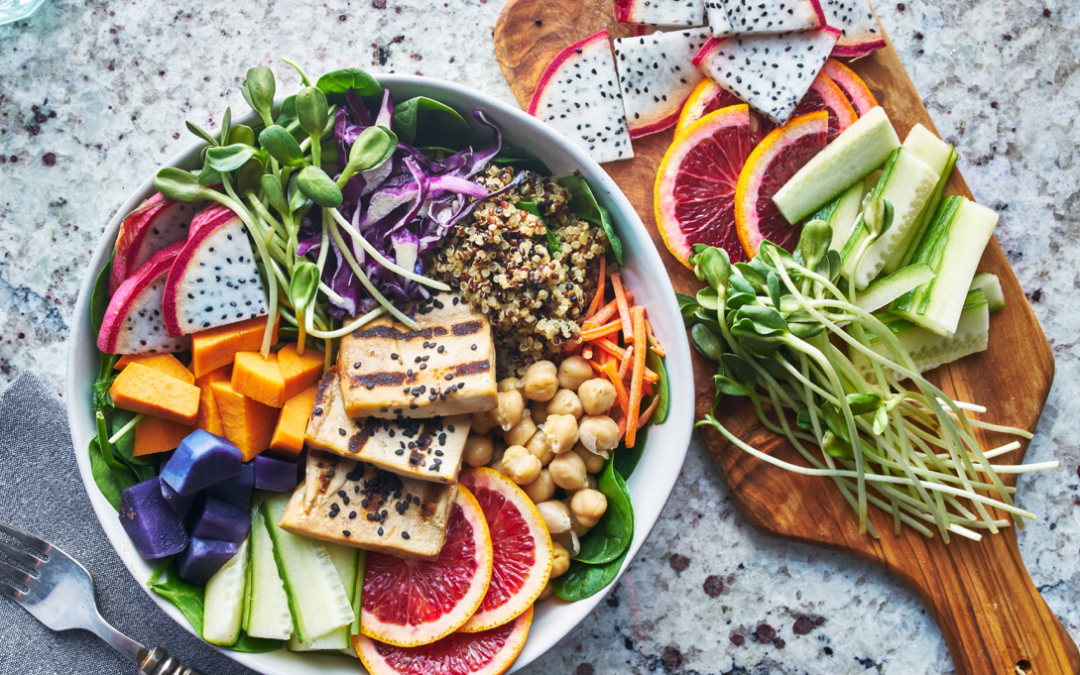
The importance of how to prepare and consume food
Food also nourishes the soul and determines our spiritual qualities. Strong feelings and emotions such as fear, anger and pain significantly interfere with digestive processes and can cause disturbances. It is very important when sitting at the table to be in a peaceful atmosphere, with the right company and to have positive thoughts. Anything that can cause concern must be kept away at the time of the meal. Yogananda explained that the digestive system is closely connected with the sympathetic nervous system and that harmful moods slow down digestion.
The same attention must be paid to the preparation of food, which must take place in a quiet, peaceful environment and the cook should maintain a state of energy and positive thoughts when preparing food.
Foods according to the season
It is also important to respect the seasonality of foods and always prefer local foods that grow in our areas. The foods of our places are more in resonance with our organism and not having undergone too many displacements, they contain more prana (vital energy). In nature, the similar increases the similar, the opposite cure, let’s keep this in mind. Here is how we can regulate ourselves:
- Autumn, cold, windy, humid climate: cooked, hot, dry foods.
- Winter, cold, dry climate: hot, humid, energetic foods.
- Spring, fresh and humid climate: hot, dry food, bitter vegetables to purify.
- Summer, hot and dry or hot and humid climate: refreshing and light foods.
What foods to prefer before and after practice
Immediately before doing yoga it would be preferable not to eat anything, if it’s morning the breakfast should be made later, if it’s evening it is better to have a light snack based on fresh fruit and dried fruit that provide energy without weighing it down.
Once the practice is over, it is advisable to first have dinner or lunch after about an hour, this to allow the teachings received during yoga to settle and allow the body to rest (in fact, let’s not forget that digestion and the whole process related to food intake involves a considerable effort on the part of our body). After yoga, if it’s a snack it is better to consume fruit or yogurt with honey, chopped fruit and muesli, if it’s a dinner, and if it’s not too late, opt for a vegetable and legume soup, or cooked vegetables and rice.

Here are some rules to remember to follow a yogic diet
- Eat according to your ability, eating too much or too little creates weakness
- Get up from the table with the feeling of not being completely satisfied
- Eat only when you’re hungry
- Do not eat before the previous meal has been digested
- Drink lukewarm water between meals
- Avoid cold foods and drinks
- Consume mainly hot food or at room temperature
- Eat meals in a peaceful environment with a relaxed mind
- Don’t argue at the table, possibly keep silent or have pleasant and relaxing conversations
- Always prefer fresh and freshly prepared foods and avoid stored and heated foods
- Eat seasonal food and possibly Km0
- Make your main meal for lunch
- In the evening, avoid difficult or long-digesting foods
- Do not consume incompatible foods
- Chew slowly and well because digestion starts in the mouth
- As you eat focus your attention on the meal, don’t think or do anything else
- Take a few minutes to relax after eating
What about you? Are you following a yogic diet, or would you like to start doing it? What are the benefits and what are the limits you have encountered? Let me know in the comments!